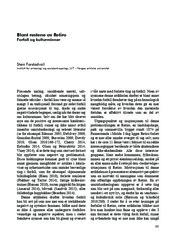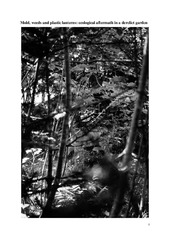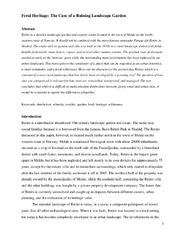| dc.contributor.advisor | Olsen, Bjørnar | |
| dc.contributor.author | Farstadvoll, Stein | |
| dc.date.accessioned | 2019-05-24T12:42:13Z | |
| dc.date.available | 2019-05-24T12:42:13Z | |
| dc.date.embargoEndDate | 2024-06-14 | |
| dc.date.issued | 2019-06-14 | |
| dc.description.abstract | This dissertation explores the contemporary archaeological record of Retiro, a derelict 19th-century
landscape garden and summer estate located in the town of Molde on the north-western coast of
Norway. The main topic that this thesis investigates is the consequences of acknowledging Retiro with
its excess of unruly and apparently ruinous characteristics, as heritage. This involves focusing on the
concrete characteristics of Retiro’s contemporary environment, from the garbage littering the forest
floor to the plants that cover its undulating topography. An underlying motivation for this inquiry is to
investigate an alternative, or more precisely, oblique way to approach and describe Retiro. This
investigation is not founded on the ambition of improving conventional historical research or cultural
heritage management, but instead explore a way of observing and including things that are usually
overlooked in these ways of representing and handling the material past in the present. Thus, the goal
is not to be reductive and instead focusing on expanding horizons based on on-site surveys. To do this
the research relies on empirical observation and experience derived from repeated on-site surveys of
Retiro.
One of the central conclusions of the research is that concern for material heritage sites like
Retiro, through oblique and inclusive approaches, can be a foundation for an environmentally oriented
archaeology of the contemporary world. This is by no means a revolutionary or radically new
assertion, as archaeology has always in some form dealt with the environment; i.e. things that are not
human or outside our control. Nevertheless, my hope is to demonstrate how archaeology can
contribute to unique ways of describing a contemporary environment, on track with how other
academic disciplines have contributed to the development of ecological and environmental studies in
the humanities and social sciences. To achieve this, it is necessary to include the apparently natural
and non-human aspects of heritage sites, and acknowledge that anthropogenic heritage is also partly
constituted by – and exists in constant dialogue with – non-humans, like plants, fungi, and
polypropylene. Our material legacies are not only inherited by humans, but also by non-humans.
Importantly, a focus on these non-human aspects does not necessarily side-line human concerns.
Rather, I argue, such focus serves to inform our understanding of how our heritage experience is
formed and inform through the vibrant afterlife of the past. | en_US |
| dc.description.doctoraltype | ph.d. | en_US |
| dc.description.popularabstract | This thesis studies the afterlife of Retiro, a derelict 19th-century garden located in the town of Molde. It explores the implications of seeing Retiro in its current ruinous and overgrown state, as heritage. This means extending heritage to things that would usually be omitted from conventional understandings, such as modern garbage and the non-native plants found there today. Data was gathered from repeated on-site surveys, during different seasons, and included such methods as photography and on-site description, seeking to highlight the unique aspects that emerge when things are left to their own devices. The concluding claim is made, that approaches like the one developed through this research can contribute to an environmentally concerned contemporary archaeology. That is, one that acknowledges how heritage is partly constituted by non-humans, like for example plants, fungi, and plastic, and which is concerned with how material heritage is inherited by both humans and non-humans. | en_US |
| dc.description.sponsorship | This work was supported by the Research Council of Norway and UiT The Arctic University of Norway under the project Object Matters: Archaeology and Heritage in the 21st Century [project code 240686]. | en_US |
| dc.identifier.uri | https://hdl.handle.net/10037/15381 | |
| dc.language.iso | eng | en_US |
| dc.publisher | UiT Norges arktiske universitet | en_US |
| dc.publisher | UiT The Arctic University of Norway | en_US |
| dc.relation.haspart | <p>Paper A: Farstadvoll, S. (2016). Blant restene av Retiro: Forfall og kulturminner. <i>Primitive tider, 18</i>, 161–181. Also available at <a href=https://hdl.handle.net/10037/15380>https://hdl.handle.net/10037/15380</a>.
<p>Paper B: Farstadvoll, S. (2019). Growing Concerns: Plants and Their Roots in the Past. <i>Journal of Contemporary Archaeology, 5</i>(2), 174–93. Also available at <a href=https://doi.org/10.1558/jca.35117> https://doi.org/10.1558/jca.35117</a>.
<p>Paper C: Farstadvoll, S. (2019). Vestigial Matters: Contemporary Archaeology and Hyperart. <i>Norwegian Archaeological Review</i>. Also available at <a href= https://doi.org/10.1080/00293652.2019.1577913> https://doi.org/10.1080/00293652.2019.1577913</a>.
<p>Paper D: Farstadvoll, S. Mold, weeds and plastic lanterns: ecological aftermath in a derelict garden. In Pétursdóttir, Þ. & Bangstad, T.R. (Eds.), <i>Heritage Ecologies</i>. Routledge. (In press).
<p>Paper E: Farstadvoll, S. Feral Heritage: The Case of a Ruining Landscape Garden. In Lee, D. (Ed.), <i>Contemporary and historical archaeologies of rurality and the rural</i>. Archaeopress. (In press). | en_US |
| dc.rights.accessRights | embargoedAccess | en_US |
| dc.rights.holder | Copyright 2019 The Author(s) | |
| dc.subject.courseID | DOKTOR-001 | |
| dc.subject | VDP::Humaniora: 000::Arkeologi: 090 | en_US |
| dc.subject | VDP::Humanities: 000::Archeology: 090 | en_US |
| dc.subject | VDP::Humaniora: 000::Arkeologi: 090::Annen arkeologi: 099 | en_US |
| dc.subject | VDP::Humanities: 000::Archeology: 090::Other archeology: 099 | en_US |
| dc.subject | Samtidsarkeologi | en_US |
| dc.subject | Contemporary archaeology | en_US |
| dc.subject | Archaeology of the contemporary world | en_US |
| dc.subject | Heritage | en_US |
| dc.subject | Heritage studies | en_US |
| dc.subject | Critical heritage studies | en_US |
| dc.subject | Materiality | en_US |
| dc.subject | Garden archaeology | en_US |
| dc.subject | Things | en_US |
| dc.subject | Ruin | en_US |
| dc.subject | Ruins | en_US |
| dc.subject | Dereliction | en_US |
| dc.subject | Entropy | en_US |
| dc.subject | Environment | en_US |
| dc.subject | Post-human | en_US |
| dc.subject | Posthuman | en_US |
| dc.subject | Post-humanism | en_US |
| dc.subject | Posthumanism | en_US |
| dc.subject | Kulturarv | en_US |
| dc.subject | Arv | en_US |
| dc.subject | Nature/culture | en_US |
| dc.subject | nature-culture | en_US |
| dc.subject | Culture/nature | en_US |
| dc.subject | culture-nature | en_US |
| dc.subject | Anthropocene | en_US |
| dc.subject | post-anthropocentric | en_US |
| dc.subject | OOO | en_US |
| dc.subject | object-oriented | en_US |
| dc.subject | on-site | en_US |
| dc.subject | unruly | en_US |
| dc.subject | Wilderness | en_US |
| dc.subject | thing-theory | en_US |
| dc.subject | Post-humanities | en_US |
| dc.subject | posthumanities | en_US |
| dc.subject | art/archaeology | en_US |
| dc.subject | archaeology/art | en_US |
| dc.subject | Landscape garden | en_US |
| dc.subject | Garden | en_US |
| dc.subject | Environmental humanities | en_US |
| dc.subject | Cultural heritage | en_US |
| dc.subject | Natural heritage | en_US |
| dc.subject | Material heritage | en_US |
| dc.title | A speculative archaeology of excess: Exploring the afterlife of a derelict landscape garden | en_US |
| dc.type | Doctoral thesis | en_US |
| dc.type | Doktorgradsavhandling | en_US |


 English
English norsk
norsk






